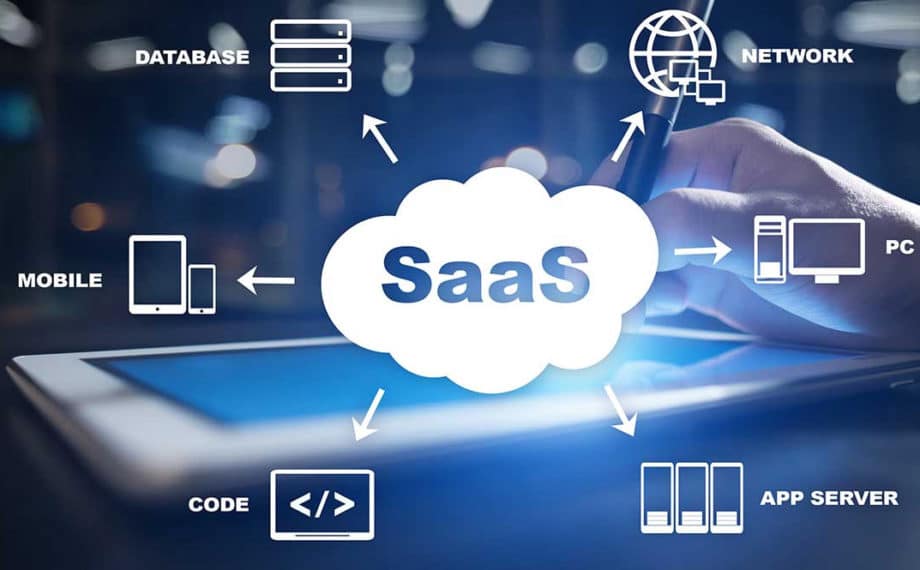SaaS (Software as a Service) has transformed the software market by offering companies flexible, scalable, reasonably priced solutions. SaaS offers improved accessibility and lets users access applications over the internet, therefore removing the need for infrastructure administration, unlike more conventional software models.
The expected CAGR for the global SaaS market from 2023 to 2030 is 13.7%. Demand for SaaS software development tools keeps rising as companies increasingly use SaaS solutions.
This need has spurred creativity, resulting in fresh trends and best practices that will define SaaS-based software development in the future. The newest SaaS development trends, breakthroughs, and best practices redefining SaaS app’s future will be discussed in this article.
Key Trends in the Future of SaaS Development

The future of SaaS development is being shaped by several key trends. Businesses and developers trying to keep ahead of their competitors depend on an awareness of these trends.
The move toward cloud-native architectures has transformed the construction of SaaS applications. Building programs from the ground up that are cloud-native – that is, fit for the cloud – is known as cloud-native development. These uses leverage the scalability, adaptability, and resilience of the cloud.
Furthermore, taking center stage is the acceptance of microservices architecture. Microservices let developers split apart massive, monolithic projects into smaller, autonomous services.
By leveraging SaaS software development services, companies can utilize this architecture to create more agile and scalable solutions. This modular approach makes it easier to scale, deploy, and maintain services independently, allowing for faster development cycles and improved system flexibility.
AI and Machine Learning Integration
SaaS apps’ functionality is changing thanks to artificial intelligence and machine learning. SaaS platforms are including these technologies to increase automation, offer real-time data, and improve client experiences. Analyzing enormous volumes of data, machine learning techniques can provide hitherto impossible insights and predictions.
Using artificial intelligence, SaaS businesses may produce smarter apps that change with user activity. As more companies see how artificial intelligence could propel efficiency and personalization, this tendency could expand.
The Rise of Low-code Development Platforms
Low-code development platforms are another trend influencing the future of SaaS. Low-code systems let non-technical users build and run applications with minimum coding, therefore facilitating their access.
These systems help companies to lower expenses, speed up the development process, and empower more people to help to create applications. Particularly as the desire for faster time-to-market rises, low-code platforms’ appeal should only expand.
Enhanced Focus on Cybersecurity
As SaaS apps proliferate, so does the necessity for strong security policies. Given the rising number of cyber threats and data breaches, SaaS companies give cyber security first importance.
Using encryption, multi-factor authentication, and frequent security updates helps SaaS providers guarantee their apps are safe. Growing security issues drive companies to search for SaaS solutions that give data security a top priority.
The Growth of Vertical SaaS Solutions
Conventional SaaS systems have concentrated on providing horizontal solutions fit for a wide spectrum of sectors. Still, vertical SaaS solutions – which are catered to particular sectors or businesses are becoming more and more popular.
According to statistics, around 78% of small businesses have invested in SaaS development solutions.
Vertical SaaS offers tools, industry-specific capabilities, and integrations addressing the distinct needs of given markets.
Among other sectors are retail, banking, and healthcare. As businesses demand more personalized solutions, vertical SaaS will play an increasingly important role in the SaaS development best practices.
Innovations Driving the Future of SaaS

SaaS is continuing to evolve thanks in great part to technological and development practice innovation. The following developments are guiding SaaS evolution toward:
API-first Development
Modern SaaS apps now center API-first development as a pillar. Under this strategy, APIs are created and built prior to the front-end or user interface. Since APIs may be simply connected with several platforms and services, this provides more freedom.
Faster development cycles, scalability, and interoperability are the only benefits of API-first development. API-first programming will become more important in providing flawless experiences as companies depend more on interfaces with other solutions.
The Role of Blockchain in SaaS
Blockchain technology extends beyond cryptocurrencies. Through improved security, openness, and trust it could transform SaaS software development services.
Blockchain guarantees regulatory compliance, safeguards of sensitive data and transaction security. Blockchain-based smart contracts also help to automate procedures, therefore lowering the need for middlemen and increasing efficiency. The part blockchain technology plays in SaaS development will keep growing as it advances.
Edge Computing and its Impact on SaaS
A developing technology called edge computing brings computation and data storage right near the data source. Edge computing lowers latency and bandwidth use, therefore enhancing performance in the framework of SaaS.
Especially for sectors that depend on real-time processing, such as IoT and autonomous cars, SaaS apps can provide faster reaction times and more dependable services by processing data at the edge of the network.
Data-driven Application Development
For companies, data is now a great advantage, and SaaS apps are growingly constructed using data-driven techniques. Through gathering and evaluating user information, SaaS systems can provide tailored experiences and enhance decision-making.
Data-driven application development is the ongoing improvement of SaaS applications’ efficiency and usefulness by means of data analytics and artificial intelligence. This innovation lets companies remain flexible and sensitive to consumer needs.
Multi-cloud and Hybrid Cloud Strategies
Seeking flexibility and risk reduction, companies are increasingly adopting multi-cloud and hybrid cloud solutions. These techniques let companies integrate public and private clouds or employ several cloud providers to maximize security, performance, and economy.
Meeting consumer needs for SaaS providers depends on supporting multi-cloud and hybrid cloud implementations. As companies pursue more control over their cloud systems, this trend will keep expanding.
SaaS Development Best Practices to Follow

Some best practices have to be followed as the SaaS scene changes to guarantee the success of SaaS projects. The following are some main guidelines developers ought to follow:
Embrace Agile Methodology
Agile development is a technique stressing iterative development, teamwork, and adaptability. Using an agile methodology helps SaaS development teams to keep flexible in changing market needs, constantly provide updates, and answer consumer comments.
Faster development cycles, better collaboration, and the capacity to meet challenges – all of which agile methods encourage – are outcomes of their application. In the fast-paced SaaS environment, where consumer expectations and market situations can shift quickly, this strategy is very helpful.
Invest in User-centered Design
The success of SaaS systems depends much on user experience (UX). Emphasizing the development of simple, user-friendly interfaces, SaaS developers must give user-centered design first priority.
Investing in UX design guarantees that users may quickly traverse the program and accomplish their objectives with the least effort. Higher user happiness, less turnover, and more client retention follow from this.
Ensure Scalability and Performance
The capacity of SaaS to scale is one of its key benefits. Building SaaS apps with scalability in mind will help you meet rising user bases and higher workloads.
Applications should be designed by developers either vertically by raising the capacity of current resources or horizontally by adding more instances of a service. Delivering speedy, dependable services also depends on performance optimization, particularly for applications with great user demand.
Prioritize Security and Data Privacy
In SaaS development security and data privacy are non-negotiable. Strong security policies must be followed by SaaS providers to safeguard private information and guarantee regulatory compliance with HIPAA and GDPR.
Implementing access restrictions, encrypting data both in transit and at rest, and routinely changing security methods to handle developing concerns comprise best practices.
Continuous Integration and Deployment (CI/CD)
Automating the integration of code changes, testing, and application deployment is CI/CD’s development tool for CI/CD pipelines lets SaaS development teams guarantee fast and effective release of new features and updates.
CI/CD guarantees always current applications lower the risk of human mistakes and automate testing and deployment procedures so promoting faster delivery of high-quality software.

The Evolution of DevOps in SaaS Development
By encouraging a culture of cooperation between development teams and IT operations, DevOps – a mix of development and operations – has been quite helpful for SaaS development. By automating chores, enhancing communication, and clearing obstacles, DevOps’ inclusion into SaaS has sped the development lifecycle.
DevOps techniques guarantee that teams in SaaS development may constantly provide improvements without compromising the end-user experience. Widely embraced to handle code integration, testing, and deployment are automation systems such as Jenkins, Docker, and Kubernetes.
The application of infrastructure as code (IaC) is fundamental for DevOps in SaaS. Using IaC, developers may control and provision cloud infrastructure using code instead of hand tools. This permits fast scaling, lowers human mistakes, and increases efficiency.
The need for DevOps to preserve constant integration and delivery will become even more crucial as SaaS applications get more complicated. This helps companies to instantly bring fresh innovations to market, maintain security patches, and instantly change with customer comments.
Customer-centricity and Personalization in SaaS
The SaaS ecosystem of today is growing customer-centric. Giving customized and bespoke experiences is a major emphasis as more SaaS companies give clients happiness first priority.
Using user data and analytics, SaaS firms today can better grasp consumer preferences, behaviors, and pain areas. This helps them to provide tailored solutions, individualized onboarding, and pertinent product suggestions.
Customizing SaaS not only increases user involvement but also helps to lower churn rates since consumers are more likely to stick to a product if they believe it is fulfilling their particular requirements. As companies aim to establish closer ties with their consumers, this hyper-personalizing tendency will keep influencing the direction of SaaS.
Conclusion

The future of SaaS is filled with exciting opportunities and innovations that will continue to shape the software industry. Low-code platforms, artificial intelligence integration, and edge computing – all of which reflect trends – have given SaaS developers more tools than ever to construct scalable, flexible, and safe applications.
Following best practices – that is, giving user-centered design first priority, adopting agile development, and stressing security – allows SaaS companies to satisfy the changing needs of companies and consumers. Maintaining success in the competitive software business will depend on keeping ahead of these tendencies as the SaaS scene develops. Driven by the fast growth of technology and the shifting needs of the digital age, SaaS-based software development promises to be dynamic and creative.





